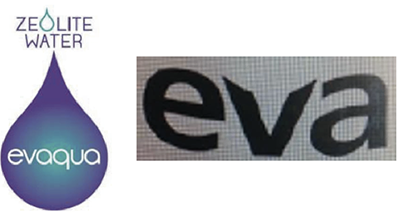Happily eva after! Time to get re-aqua-ainted with global assessment
In February 2019, EvaQua s.r.o. (EvaQua) applied to register the EUTM (below left) in class 32. Envasados Eva S.A. (Eva) opposed the application under Articles 8(1)(a) and (b) based on a number of earlier rights, all covering identical goods. The opposition was assessed on the basis of the mark shown below right:

The opposition division dismissed the Article 8(1)(a) ground immediately, because the marks were clearly not identical. As regards 8(1)(b), identical goods were covered, which were aimed at the public at large whose attention was deemed to be average. The opposition turned on the degree of similarity between the marks.
The opposition division held that the relevant public would perceive the earlier mark as a female first name, which was distinctive for the goods in question.
In the later mark, the opposition division held that some consumers would perceive ZEOLITE as referring to minerals containing sodium, potassium and other elements; for others, it would be meaningless. In any event ZEOLITE was held to be distinctive of the goods.
The verbal element “evaqua” had no meaning, but consumers were likely to break it down into recognisable parts such as AQUA, which many would perceive as a reference to water (having a weak distinctive character for beverages). Consumers may also see the word EVA, which is distinctive of such products.
The signs coincided as regards EVA. They differ in QUA, ZEOLITE and WATER and their figurative elements/colours. The marks were therefore visually and phonetically similar to at most only a very low degree; and conceptually similar to only a low degree, since consumers would have to go through a mental step to recognise the EVA element in the later mark, and some would not.
Overall the similarities were deemed insufficient for a finding of a likelihood of confusion.
Board of Appeal
Eva appealed, arguing that all elements of the later mark made reference to water in some way. The only real “trade mark” element was EVA. Although EVAQUA has no meaning, the applicant was obviously trying to achieve an association between the words EVA and AQUA. Visually the application would be seen by consumers as EVA. Conceptually the marks are also very similar: EVA for water/beverage products; and EVAQUA = EVA AQUA = EVA WATER.
The Board of Appeal confirmed that English-speaking consumers would perceive the name EVA in the earlier mark, which was distinctive for beverages; and that “a significant part of the English-speaking public” would interpret ZEOLITE in the later mark as meaning water purified or softened with zeolite minerals. This expression was therefore descriptive. The opposition division had incorrectly considered ZEOLITE to be distinctive.
When perceiving a verbal sign consumers will break it down into elements which suggest a concrete meaning or resemble known words. English-speaking consumers would break down EVAQUA into EVA (distinctive for beverages) and AQUA (very weak).
EVAQUA was the most distinctive element of the application, and since that contained the earlier mark in its entirety at the beginning, there were undeniable similarities. The additional elements of the application counterbalanced those only to a limited extent, particularly since they possess limited distinctive character, and since EVAQUA is central within the application. Word elements normally have more of an impact on consumers than figurative elements.
The Board of Appeal held the visual similarities to be low, not at the most very low; and the phonetic similarities to be average, disagreeing with the opposition division that consumers would take a mental step to dissect EVA from EVAQUA. If the name EVA was recognised in both marks, which would be the case for a significant number of consumers, the overall conceptual similarity between the marks was average.
In short, the elements in the application other than EVA did not have the same degree of distinctive character as EVA, and the figurative elements did not add any distinctiveness to the weaker verbal elements.
As such, the Board of Appeal found that as a result of the low degree of visual similarity, the average degree of phonetic and conceptual similarity, and the identity of the goods, there was a likelihood of confusion between the marks for English-speaking consumers. The appeal was therefore upheld.
In short
The case serves as a reminder that when two marks share a distinctive verbal element, the presence of additional verbal and figurative elements, if each of these is deemed to be relatively non-distinctive in and by themselves, will not necessarily suffice to avoid a likelihood of confusion.

